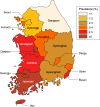Outcomes of infants born to pregnant women with syphilis: a nationwide study in Korea
- PMID: 33478429
- PMCID: PMC7821395
- DOI: 10.1186/s12887-021-02502-9
Outcomes of infants born to pregnant women with syphilis: a nationwide study in Korea
Abstract
Background: Despite the expansion of antenatal syphilis screening programs, congenital syphilis (CS) remains a concern.
Purpose: This study aimed to analyze the manifestation and progress of CS, including treatment and follow-up, based on a nationwide study.
Methods: From the Korean National Health Insurance Service database, a total of 548 infants were examined for CS during their first year of life from 2013 to 2018. Neurosyphilis and complications were investigated using the International Classification of Diseases-10 codes.
Results: The birth rate of infants from mothers with syphilis was 2.8 per 10,000 live births for 5 years, which is not indicative of a decreasing trend. Overall, 148 infants were proven or highly probable or possible of having CS with treatment for 10 days; 66 infants were possible or less likely of having CS with only 1-day treatment. Jaundice (56 %) was common, followed by hearing impairment (14 %), renal disease (8 %), and mental retardation (8 %). Fourteen cases of neurosyphilis occurred. Infants with complications, including mental retardation, eye involvement, hearing impairment, or renal disease, were significantly associated with neurosyphilis (OR 8.49, P < 0.0001). Of 250 patients who received treatment, 92.8 % were treated with one medication: benzathine penicillin was used in 73 % of patients. Only four patients were re-treated due to treatment failure. In addition to the treponemal test, fluorescent treponemal antibody-absorption was the most utilized tool for diagnosis and follow-up.
Conclusions: Establishing standardized guidelines for the evaluation of CS, as well as the establishment of treatment regimens and follow up-plans for the disease, at a national level would help improve maternal and neonatal care and facilitate the eradication of CS in Korea.
Keywords: Congenital syphilis; Neurosyphilis; Outcome.
Conflict of interest statement
All authors declare that they have no conflict of interests related to this study.
Figures
Similar articles
-
Risk of Congenital Syphilis (CS) Following Treatment of Maternal Syphilis: Results of a CS Control Program in China.Clin Infect Dis. 2017 Aug 15;65(4):588-594. doi: 10.1093/cid/cix371. Clin Infect Dis. 2017. PMID: 28444157
-
Maternal/congenital syphilis in a large tertiary-care urban hospital.Clin Infect Dis. 1993 Dec;17(6):1041-6. doi: 10.1093/clinids/17.6.1041. Clin Infect Dis. 1993. PMID: 8110928
-
Estimating Benzathine Penicillin Need for the Treatment of Pregnant Women Diagnosed with Syphilis during Antenatal Care in High-Morbidity Countries.PLoS One. 2016 Jul 19;11(7):e0159483. doi: 10.1371/journal.pone.0159483. eCollection 2016. PLoS One. 2016. PMID: 27434236 Free PMC article.
-
Congenital Syphilis: A Discussion of Epidemiology, Diagnosis, Management, and Nurses' Role in Early Identification and Treatment.Adv Neonatal Care. 2018 Dec;18(6):438-445. doi: 10.1097/ANC.0000000000000534. Adv Neonatal Care. 2018. PMID: 30020089 Review.
-
The diagnosis and management of maternal and congenital syphilis.J Nurse Midwifery. 1992 Jan-Feb;37(1):4-16. doi: 10.1016/0091-2182(92)90017-w. J Nurse Midwifery. 1992. PMID: 1538267 Review.
Cited by
-
Beyond TORCH: A narrative review of the impact of antenatal and perinatal infections on the risk of disability.Neurosci Biobehav Rev. 2023 Oct;153:105390. doi: 10.1016/j.neubiorev.2023.105390. Epub 2023 Sep 13. Neurosci Biobehav Rev. 2023. PMID: 37708918 Free PMC article. Review.
-
Challenges and outcomes of implementing a national syphilis follow-up system for the elimination of congenital syphilis in Cambodia: a mixed-methods study.BMJ Open. 2023 Jan 10;13(1):e063261. doi: 10.1136/bmjopen-2022-063261. BMJ Open. 2023. PMID: 36627153 Free PMC article.
-
Maternal-Fetal Infections (Cytomegalovirus, Toxoplasma, Syphilis): Short-Term and Long-Term Neurodevelopmental Outcomes in Children Infected and Uninfected at Birth.Pathogens. 2022 Oct 31;11(11):1278. doi: 10.3390/pathogens11111278. Pathogens. 2022. PMID: 36365029 Free PMC article.
-
Le diagnostic et la prise en charge de la syphilis congénitale : ne laisser passer aucune occasion.Paediatr Child Health. 2024 Dec 12;29(7):463-479. doi: 10.1093/pch/pxae040. eCollection 2024 Nov. Paediatr Child Health. 2024. PMID: 39677392 Review.
-
Computational methods applied to syphilis: where are we, and where are we going?Front Public Health. 2023 Aug 23;11:1201725. doi: 10.3389/fpubh.2023.1201725. eCollection 2023. Front Public Health. 2023. PMID: 37680278 Free PMC article.
References
-
- World Health Organization. Global strategy for the prevention and control of sexually transmitted infections: 2006–2015. http://www.who.int/reproductivehealth/publications/rtis/9789241563475/en. Accessed 04-Aug-2020.
Publication types
MeSH terms
Grants and funding
LinkOut - more resources
Full Text Sources
Other Literature Sources
Medical


